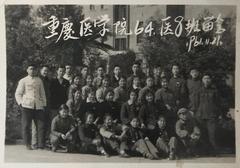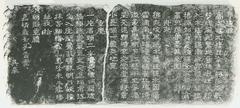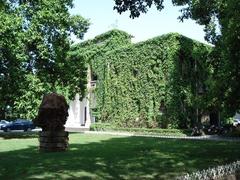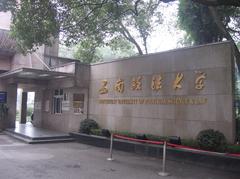Shimenshan Cliffside Carvings: Visiting Hours, Tickets, and Chongqing Historical Sites Guide
Date: 04/07/2025
Introduction
The Shimenshan Cliffside Carvings, a remarkable facet of the UNESCO-listed Dazu Rock Carvings in Chongqing, China, offer visitors an unparalleled window into China’s religious syncretism, cultural sophistication, and artistic achievement. Nestled amid the serene cliffs of Dazu District, Shimenshan stands out for the intricacy of its more than 70 statues, its vivid preservation, and the harmonious coexistence of Buddhist, Taoist, and Confucian symbolism.
Less frequented than its grander counterparts like Baodingshan and Beishan, Shimenshan rewards the traveler with an intimate and contemplative experience. Its secluded location has helped maintain the vivid detail and color of the original carvings, making it a hidden gem for art lovers, spiritual seekers, and cultural explorers. This comprehensive guide covers everything you need to know for your visit, including history, tickets, accessibility, travel tips, and the unique place Shimenshan holds in the legacy of Chinese grotto art (China Educational Tours; Peace Lily Site; Official Dazu Tourism Website).
Historical Overview of Shimenshan Cliffside Carvings
Origins and Artistic Flourishing
The Shimenshan Cliffside Carvings trace their origins to the late Tang Dynasty (618–907 CE), reaching their height in the Song Dynasty (960–1279 CE). This was a period marked by religious syncretism and artistic innovation, with artisans carving over 70 statues into 12 distinct niches and grottoes along the cliff face. Unlike the sprawling northern grottoes, Shimenshan’s scale is modest but its artistry is profound, characterized by expressive faces, delicate proportions, and a unique blend of religious motifs (China Educational Tours).
Religious and Artistic Syncretism
Shimenshan is celebrated for its seamless integration of Buddhist, Taoist, and Confucian iconography. Statues of Taoist immortals, Buddhist bodhisattvas, and Confucian sages appear side-by-side, often accompanied by symbolic creatures like the peacock, a powerful emblem of beauty and spiritual transcendence. This syncretic approach reflects an era of remarkable philosophical maturity and local religious tolerance (Peace Lily Site).
Place within the Dazu Rock Carvings Complex
Shimenshan is one of five main sites in the Dazu Rock Carvings complex, along with Baodingshan, Beishan, Nanshan, and Shizhuanshan. Collectively, these sites encompass more than 50,000 statues and 75 separate carving locations, representing the zenith of Chinese cave temple art from the 9th to 13th centuries. Shimenshan’s relative seclusion has helped preserve its unique artistic traditions and original color, despite turbulent historical periods (Peace Lily Site).
Artistic Features and Iconography
- Expressive Craftsmanship: The sculptures exhibit high and shallow relief carving, with life-like figures whose faces and gestures convey deep emotion.
- Symbolic Motifs: The peacock, Taoist immortals, Buddhist deities, and Confucian themes all feature prominently. Inscriptions tell of the craftsmen, like Wen Weiyi and Wen Judao, who contributed to this collaborative masterpiece.
- Narrative Depth: The carvings narrate spiritual and moral tales, from Taoist assemblies to Buddhist parables and Confucian teachings on filial piety.
- Song Dynasty Style: Emphasis on naturalism, subtlety, and the integration of religious and secular themes distinguish Shimenshan’s style.
Preservation and Recognition
Shimenshan’s protected southern location spared it from much of the iconoclasm and destruction that befell other sites. The Chinese government recognized its cultural value as early as 1961, and UNESCO inscribed the Dazu Rock Carvings as a World Heritage Site in 1999, highlighting Shimenshan’s significance as a symbol of religious and artistic harmony (China Educational Tours).
Visiting Information: Hours, Tickets, and Accessibility
- Visiting Hours: Typically open daily from 8:00 AM to 5:30 PM (last entry around 5:00 PM). Hours may vary seasonally; check official sources before your visit.
- Tickets: Standard admission is approximately 75–90 RMB for adults, with discounts for students, seniors, and groups. Tickets can be purchased onsite or online through authorized platforms.
- Accessibility: The site features uneven paths and stairs; some areas are accessible for those with limited mobility, but preparation is advised. Guided tours accommodating accessibility needs are available.
- Audio Guides: Available for rent at the entrance in multiple languages.
Getting There and Nearby Attractions
- Location: Shimenshan is situated about 70 kilometers from central Chongqing, in Dazu District.
- Transportation:
- By Bus: Direct buses depart from Chongqing city center.
- By Taxi or Car: Taxis and car rentals with GPS are convenient; parking is available.
- Guided Tours: Many agencies offer transport-inclusive tours with expert guides.
- Nearby: Combine your visit with Baodingshan and Beishan for a broader Dazu experience, or explore local sites like Changzhou Ancient Town.
On-Site Facilities
- Visitor Center: Provides maps, information, and brochures.
- Restrooms: Located near the entrance and main viewing areas.
- Food and Drink: Snack stalls and local dining options in nearby villages.
- Shuttle Service: Electric shuttles connect parking areas to main carving clusters.
Travel Tips and Recommendations
- Best Time to Visit: Spring (March–May) and autumn (September–November) offer mild weather.
- Peak Times: Visit on weekdays or early mornings for a quieter experience. National holidays are busiest.
- Clothing: Wear comfortable shoes for walking and bring sun/rain protection.
- Photography: Allowed, but avoid flash and tripods to protect the carvings.
- Language: English is limited—use translation apps or hire a bilingual guide.
- Payments: Carry cash (RMB); some places accept mobile payment.
Frequently Asked Questions (FAQ)
Q: What are the Shimenshan visiting hours?
A: Generally 8:00 AM to 5:30 PM, though seasonal variations may apply. Check before your visit.
Q: How do I buy tickets?
A: Purchase onsite or through authorized travel agencies; online tickets are available via official platforms.
Q: Is Shimenshan accessible for visitors with disabilities?
A: Some areas are accessible, but the terrain can be challenging. Contact the visitor center for details.
Q: Are guided tours available?
A: Yes, in multiple languages, including English. Audio guides are also available.
Q: Can I take photos at the site?
A: Photography is allowed, but flash and tripods may be restricted.
Shimenshan’s Cultural and Artistic Legacy
Shimenshan is essential for understanding the full spectrum of the Dazu Rock Carvings’ religious, artistic, and social history. Its carvings reflect the peaceful coexistence of China’s major spiritual traditions, serving as both a spiritual sanctuary and a masterpiece of Song Dynasty art. Its preservation ensures that future generations can appreciate its unique beauty, and its influence extends to religious sculpture across southwest China (Peace Lily Site).
Timeline of Key Historical Milestones
- Late Tang Dynasty (circa 9th century): Initial carvings at Shimenshan begin.
- Song Dynasty (960–1279): Artistic and religious syncretism peaks.
- 1961: Designated as a protected heritage site by the Chinese government.
- 1999: Included in the UNESCO World Heritage List.
Responsible Tourism and Visitor Etiquette
- Preservation: Do not touch or climb on the carvings; stay on marked paths.
- Respect: Maintain a quiet atmosphere, especially in spiritual areas.
- Support Local Communities: Purchase local products and dine in nearby villages.
- Litter: Use bins provided to help conserve the site.
Visual and Interactive Resources
- High-resolution photographs and virtual tours are available on official websites and platforms.
- Suggested alt tags:
- “Shimenshan Cliffside Carvings peacock statue”
- “Panorama of Shimenshan cliffside niches”
- “Map of Shimenshan Cliffside Carvings in Chongqing”
- Interactive maps of Dazu Rock Carvings highlight Shimenshan’s location for easy navigation.
Internal Links
External Resources
- China Educational Tours - Dazu Rock Carvings
- Peace Lily Site - Dazu Rock Carvings
- Official Dazu Tourism Website
- UNESCO Dazu Rock Carvings Page
- Chongqing Travel Guide
Conclusion
A visit to the Shimenshan Cliffside Carvings is a journey through time, art, and spiritual heritage. This site, with its exceptional preservation and intimate scale, offers a rare opportunity to connect with a defining era of Chinese religious and artistic history. Whether you are a cultural explorer, spiritual pilgrim, or art enthusiast, Shimenshan’s carvings invite you to reflect on the enduring beauty and harmony of China’s cultural tapestry. For the latest updates, guided tours, and travel tips, download the Audiala app and follow our social media channels.
Sources











